
Yoga For Beginners: 16 Great Poses To Begin Your Practice
It’s fair to say that the rumors are right – yoga is really, really great for our physical, mental, and emotional well-being. If you’re here, you’ve likely heard about all the reasons to embrace yoga but might be unsure of where to begin. In this guide, we’ll explore yoga for beginners and 16 poses, or asanas, you can incorporate into your practice.
Here’s what we’re going to cover:
- 16 Yoga Poses For Beginners
- Incorporating These Poses into Your Practice
- Listening To Your Body
Let’s dive in.
16 Yoga Poses For Beginners
1. Mountain Pose (Tadasana)
We begin with the foundation of many yoga sequences: Mountain Pose, and there’s more to this one than you might think!
This simple yet powerful pose focuses on alignment and awareness.
Stand tall with your feet together, shoulders relaxed, and palms facing forward. Gaze straight ahead and breathe deeply.
This pose helps improve posture and align your body by stacking your shoulders, hips, and feet over one another.
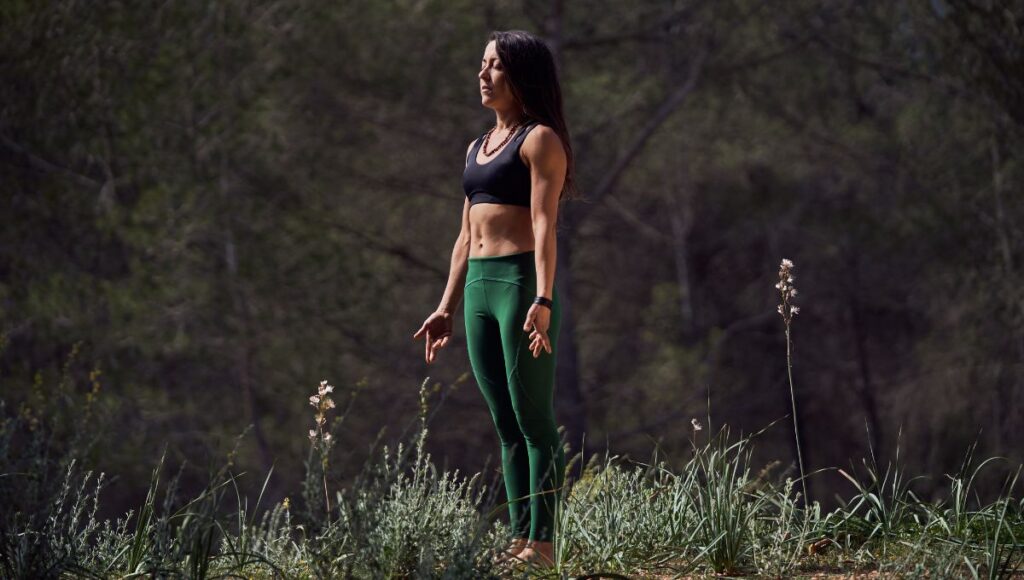
2. Downward-Facing Dog (Adho Mukha Svanasana)
One of yoga’s most recognizable poses, Downward Dog is an essential pose that challenges, stretches, and strengthens the whole body.
Start on your hands and knees in table top position, then lift your hips upward, creating an inverted V-shape with your body. Press your palms firmly into the ground, extend through the back of the legs, and work the heels towards the ground. If you have tight hamstrings, it’s best to focus on lengthening the spine instead of the backs of the legs.
This pose enhances flexibility and strength in the upper body, as well as relieves tension in the back and legs.
3. Child’s Pose (Balasana)
For a soothing and restorative pose, look no further than Child’s Pose.
Kneel on the floor, sit back on your heels, and reach your arms forward, lowering your forehead to the ground. You can choose to have the knees wide or together. If your forehead doesn’t reach the floor (which is very common in beginner yogis) then rest your head on a pillow, block, or blanket.
It’s a fantastic relaxation pose that calms the mind, stretches the spine, and releases tension.
4. Warrior I (Virabhadrasana I)
The Warrior I pose is perfect for building strength and stability.
Start in mountain pose and step one foot behind you, take the back foot to a 45-degree angle, and bend your front knee at a 90-degree angle. Extend the back leg out long, pressing both feet into the mat. Raise your arms overhead with the shoulders relaxed and hold the position.
This pose strengthens your legs, improves balance, and instills a sense of empowerment.
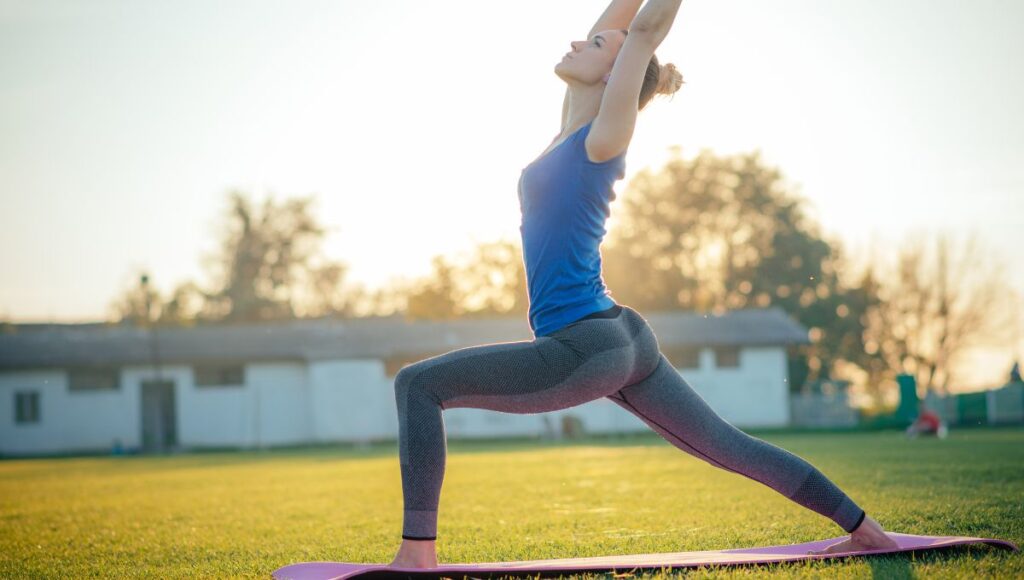
5. Bridge Pose (Setu Bandha Sarvangasana)
Bridge Pose is excellent for strengthening the lower back, glutes, and hamstrings.
Lie on your back with your knees bent, and feet hip-width apart. Lift your hips off the ground while pressing your arms and shoulders into the floor.
This pose helps counteract the effects of prolonged sitting, making it ideal for those with desk jobs.
6. Tree Pose (Vrksasana)
Tree Pose is a wonderful way to improve balance, focus, and stay grounded.
Stand with your feet together, shift your weight to one leg, and place the sole of your other foot against the inner thigh of the standing leg. Bring your hands to your heart center and hold the position.
This pose enhances concentration and balance while opening up the hips.
7. Cat-Cow Pose (Marjaryasana-Bitilasana)
The Cat-Cow pose is a gentle and rhythmic movement that combines two poses.
Begin on your hands and knees, arch your back while inhaling (Cow Pose), and round your back while exhaling (Cat Pose).
This sequence is excellent for spinal flexibility and can be a soothing part of your warm-up or cool-down routine – I try to practice this pose daily!
8. Sphinx Pose (Salamba Bhujangasana)
Sphinx Pose is a gentle backbend that strengthens the spine.
Lie on your stomach, prop yourself up on your forearms, and gently arch your back while keeping your pelvis on the ground.
This pose promotes improved posture, alleviates lower back pain, and gently engages the core muscles.
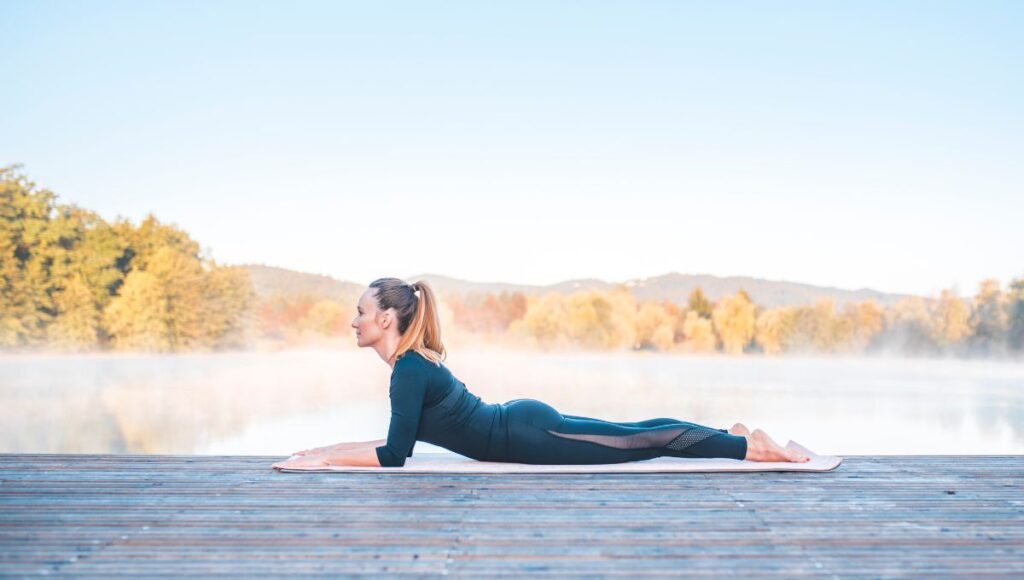
9. Warrior II (Virabhadrasana II)
Warrior II is another empowering pose that strengthens your legs and improves your balance.
Begin with your feet wide apart, turn one foot toward the front of the mat and another one parallel to the short edge of the mat – bend this leg to a 90-degree angle. Extend your arms parallel to the ground, gazing over the front hand.
This pose promotes focus, stability, and builds endurance.
10. Seated Forward Bend (Paschimottanasana)
The Seated Forward Bend is excellent for stretching the hamstrings, lower back, and spine.
Sit with your legs extended, toes flexed toward you, and reach forward as far as you comfortably can, hinging from the hips. Don’t overstrain the hamstrings, you’ve got plenty of time to work on it!
This pose encourages flexibility, relaxation, and definitely patience.
11. Cobra Pose (Bhujangasana)
Cobra Pose is a backbend that strengthens the back and opens the chest.
Lie on your stomach, place your hands near your shoulders, and gently lift your upper body while keeping your pelvis on the ground. Don’t extend the arms out fully, just go as far as that’s comfortable.
It’s a great pose for improving posture and relieving back tension.
12. Half Boat Pose (Ardha Navasana)
Boat Pose is perfect for strengthening your core muscles and improving posture.
Sit with your legs in front of you with a bend in the knee, lean back slightly, and lift your feet off the ground while balancing on your sit bones. Extend your arms parallel to the ground, reaching forward with the palms facing one another.
This pose works on your abdominal muscles and balance.
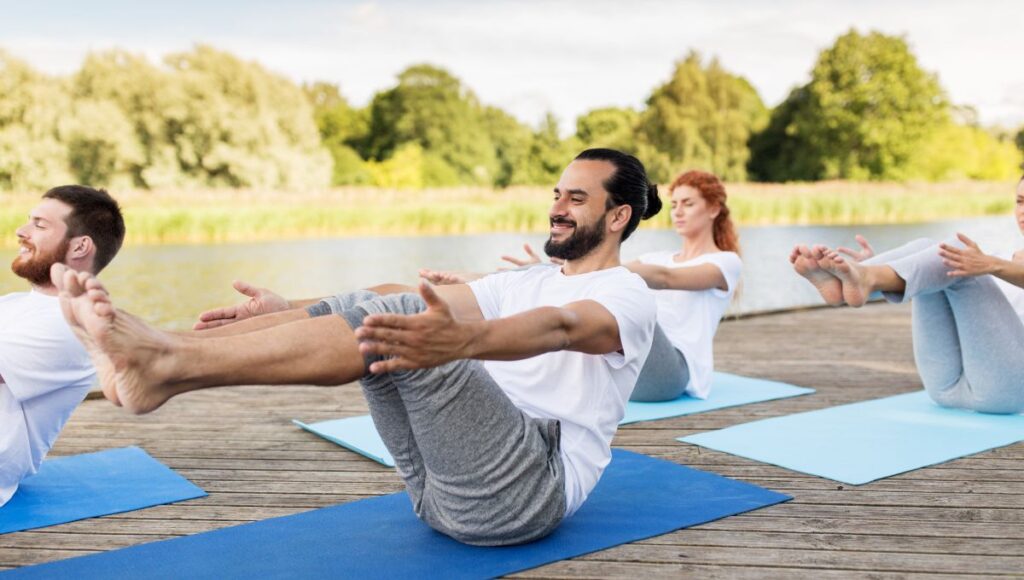
13. Child’s Pose Variation (Extended Child’s Pose)
This variation of Child’s Pose adds a shoulder stretch.
Kneel on the ground, sit back on your heels, and extend your arms forward as in the classic Child’s Pose. Then, walk your hands to one side, feeling the stretch along your side and shoulders.
This pose helps to release upper body tension.
14. Plank Pose
Plank Pose is a full-body strengthening pose that primarily targets your core, arms, and shoulders.
Begin in a push-up position, then push the body off the floor, keeping in one straight line from your head to heels.
Plank is fantastic for building strength across the whole body and developing a strong core.
15. Legs Up the Wall Pose (Viparita Karani)
This restorative pose is great for reducing stress and promoting relaxation – it’s a great one to add to your before-bed routine.
Sit with your side against a wall, then swing your legs up the wall while lying on your back. Your body forms an L-shape.
It helps to relieve tension in the legs and lower back while calming the mind.
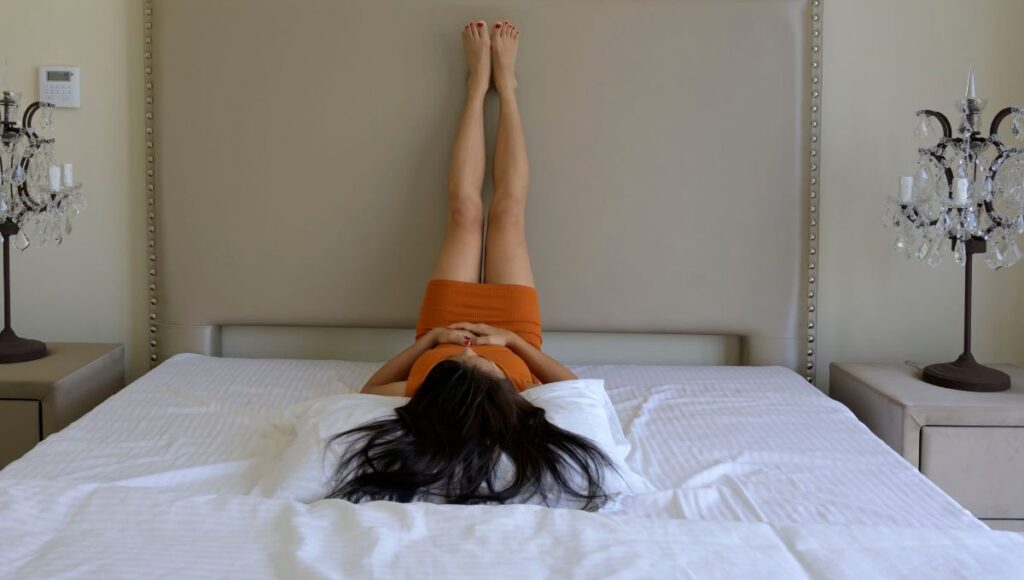
16. Extended Triangle Pose (Utthita Trikonasana)
Extended Triangle Pose is another standing pose that enhances flexibility and strength.
Begin with your feet wide apart and move the feet in the same position as Warrior 2. Keeping the legs straight, reach the front arm down the front leg, extending the other arm upward and creating a triangle shape with your body.
This pose stretches the sides of your body and improves balance.
Incorporating These Poses into Your Practice
Now that we’ve introduced these yoga poses for beginners, let’s discuss how to incorporate them into your wellness, fitness, or yoga routine.
1. Daily Practice
Begin with a 10-15 minute daily routine featuring a few of these poses. Gradually increase the duration as you become more comfortable with them.
2. Warm-Up and Cool Down
Include some of these poses in your warm-up and cool-down routines when engaging in other forms of exercise, like jogging or weightlifting.
3. Yoga Classes
Consider joining a beginner’s yoga class, either in-person or online, where an instructor can guide you through these poses and ensure proper form.
4. Set Goals
Set achievable goals for your yoga practice, such as working on flexibility, strength, or relaxation. Track your progress and celebrate your achievements.
5. Mindfulness and Breath
Remember that yoga is not just about physical poses but also about mindfulness and breathing. Incorporate deep, rhythmic breathing into your practice for enhanced mental and emotional well-being.
Listen To Your Body
In your yoga practice, it’s crucial to remember that it’s not about striving for perfection but about tuning into your body and embracing what feels good and right for you. Yoga is a deeply personal journey, and each day on the mat is unique.
Listen to your body’s signals and be kind to yourself. If a pose feels uncomfortable or if you experience pain, it’s perfectly acceptable to modify it or even skip it altogether. Yoga is a practice of self-compassion, self-discovery, and self-care.
Embrace your limitations and allow yourself to grow at your own pace. The essence of yoga lies in the mindful connection between your breath, body, and soul, so let your intuition be your guide! By tuning into your body and accepting it for what it is on any given day, you learn to treat yourself with kindness and patience. This positive and self-compassionate relationship with your body extends beyond the mat and into daily life – and is something we could all do with having more of!

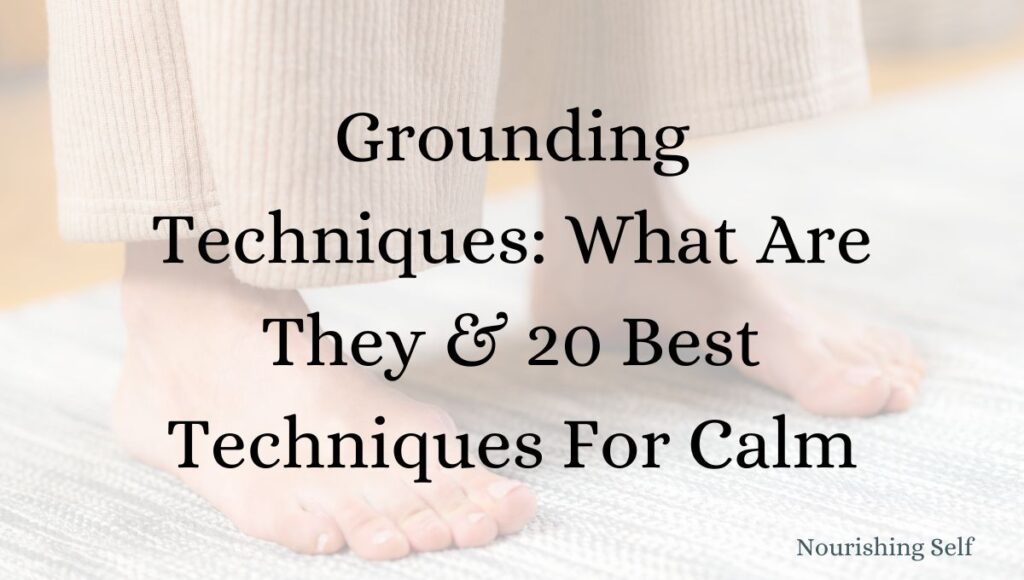
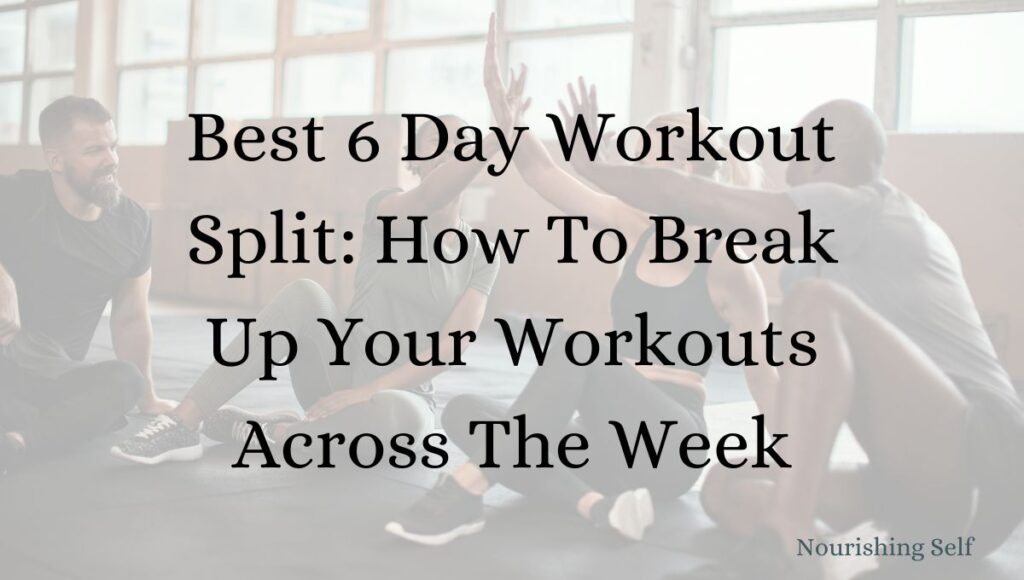

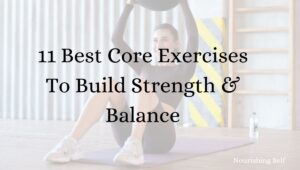
Comments (4)
11 Best Core Exercises To Add To Your Workouts & Improve Your Strength – Nourishing Self
November 9, 2023 at 11:51 am
[…] to start slowly, particularly if you’re new to core exercises. Rushing into a rigorous routine can lead to strain or injury. It’s crucial […]
Yoga For Better Sleep: 12 Best Practices & Tips To Get Better Rest – Nourishing Self
November 10, 2023 at 11:24 am
[…] for us, there is a natural solution that can help you drift off – yoga! With many of our minds constantly racing with worries and thoughts that make it difficult to […]
Grounding Techniques: What Are They & 20 Best Techniques For Calm – Nourishing Self
November 10, 2023 at 3:44 pm
[…] in gentle stretching exercises or practicing yoga can help ground your mind by bringing awareness to physical sensations in your body while promoting […]
Tree Pose Yoga: Tips, How To & Common Mistakes – Nourishing Self
November 10, 2023 at 3:44 pm
[…] beginners, it’s common to wobble or lose balance when attempting this pose. Don’t worry; […]
Comments are closed.